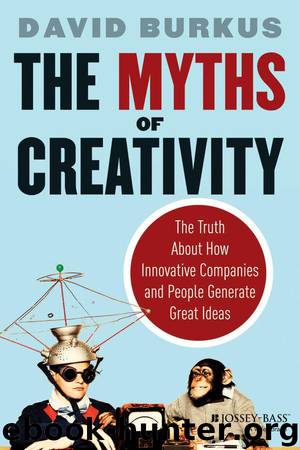The Myths of Creativity: The Truth About How Innovative Companies and People Generate Great Ideas by Burkus David

Author:Burkus, David [Burkus, David]
Language: eng
Format: mobi, epub
Publisher: Wiley
Published: 2013-09-26T00:00:00+00:00
7
The Lone Creator Myth
We have a tendency to favor stories of one person against the entire world. We likewise tend to attribute creative works or innovative ideas to one lone creator, even when that person isn't solely responsible. We love to imagine the starving poet slaving away in his sparse apartment, the genius painter who keeps her artwork so closely guarded that it rarely makes it into shows before her death, or the heroic inventor working with nothing but his intelligence and a pile of junk. We might accept that outside influences helped inspire creators, but we tend to view the act of creation as a lonely endeavor. This is the Lone Creator Myth. It's the belief that creativity is a solo performance and that the story of innovations can be told as the story of a single person working fervently on the new idea. In the popular media, this myth sells. Magazines, newspapers, and books are filled with stories of lone creative geniuses. These stories tend to ignore a truth behind all great innovations and creative works: those geniuses typically had teams. But only rarely is consideration given to the larger team or network those individuals were connected to, and often even then it is a footnote in the “soloist's” story.
Once we realize that creativity is a team effort and understand how to develop the most creative teams, we can generate even more great ideas. Too often, however, we prefer to recognize only one person for an outstanding creative work. This isn't just a selective revision; it's a fabrication. The story of one of the most famous inventions, the invention we use as a symbol of innovation, involves just such a fabrication.
Thomas Edison didn't try ten thousand times before inventing the lightbulb.
That notion is false on three different fronts. Edison didn't invent the lightbulb so much as he refined it. There weren't ten thousand attempts to find the right filament to use in the lightbulb, and, perhaps most important, it really wasn't Edison doing all that trying. The story of Edison alone in a workshop experimenting with ten thousand different materials isn't true even though it was most likely first told by Edison himself. Edison may have spread this story to help sell his invention, but the story's popularity has caused it to become a potentially dangerous myth.
In tracing the origin of the lightbulb, historians Robert Friedel and Paul Israel compiled a list of twenty-two people who invented incandescent lamps before Edison even filed his first patent for a lightbulb.1 John W. Starr, who filed a caveat for a U.S. patent in 1845 but died shortly afterward, was among those who preceded Edison.2 When Edison filed his first patent related to electric lamps, it was rejected because the patent office felt that it infringed on Starr's preexisting patent. After making a few adjustments to his design, Edison filed a patent titled “Improvement in Electric Lights” in 1878. At the time, however, the right filament was still an unsettled issue.
Depending
Download
The Myths of Creativity: The Truth About How Innovative Companies and People Generate Great Ideas by Burkus David.epub
This site does not store any files on its server. We only index and link to content provided by other sites. Please contact the content providers to delete copyright contents if any and email us, we'll remove relevant links or contents immediately.
Hit Refresh by Satya Nadella(9084)
The Compound Effect by Darren Hardy(8872)
Change Your Questions, Change Your Life by Marilee Adams(7687)
Nudge - Improving Decisions about Health, Wealth, and Happiness by Thaler Sunstein(7659)
The Black Swan by Nassim Nicholas Taleb(7058)
Deep Work by Cal Newport(6969)
Rich Dad Poor Dad by Robert T. Kiyosaki(6514)
Daring Greatly by Brene Brown(6475)
Principles: Life and Work by Ray Dalio(6297)
Playing to Win_ How Strategy Really Works by A.G. Lafley & Roger L. Martin(6085)
Man-made Catastrophes and Risk Information Concealment by Dmitry Chernov & Didier Sornette(5957)
Digital Minimalism by Cal Newport;(5706)
Big Magic: Creative Living Beyond Fear by Elizabeth Gilbert(5679)
The Myth of the Strong Leader by Archie Brown(5458)
The Slight Edge by Jeff Olson(5379)
Discipline Equals Freedom by Jocko Willink(5337)
The Motivation Myth by Jeff Haden(5176)
The Laws of Human Nature by Robert Greene(5082)
Stone's Rules by Roger Stone(5053)
